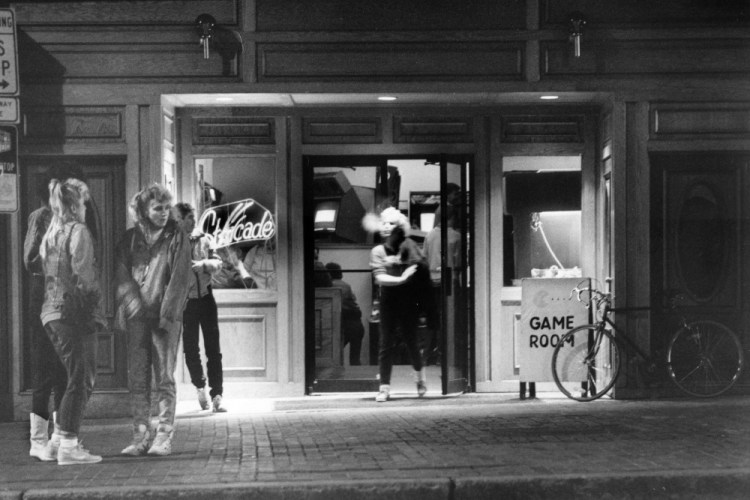Before her murder in May 1989, when police divers pulled the 16-year-old’s body from Casco Bay, Jessica L. Briggs lived a life between two worlds, and in the middle was the city of Portland.
For Briggs and other teenagers like her, the city was a refuge, where young people like her could live and get by.
In the same group was Anthony Sanborn Jr., a stoic, handsome young man with a reputation as a good fist-fighter with a difficult family life. His family’s house on Oxford Street was more a place where he kept his stuff than a real home.
Briggs, originally from Augusta, fled the Maine Youth Center to live independently of her father and stepmother, joining an informal, regular crowd of teenagers who left school and lived on the streets, sleeping on friends’ couches or at shelters and eating at soup kitchens.
At the time of her death, Briggs was attempting to get her life together. She had a new job and was trying to keep out of trouble, court records show.
“Troubled kids, especially if they were abused or neglected or gay, would come to Portland from (other towns in) Maine, and a lot of them were living on the street,” said Paul Aranson, the Cumberland County district attorney from 1982 to 1990. “Portland was the city and there was access to panhandling and resources and other people of similar experiences and circumstances.”
The police investigation centered on Briggs’ friends and led eventually to Sanborn, a one-time boyfriend of Briggs, according to court records and news reports at the time. When he was convicted at trial in 1992, the jury’s guilty verdict hung largely on the testimony of another troubled girl who was living on the streets: Hope Cady, who was 13 at the time and told detectives that she watched Sanborn kill Briggs on the Maine State Pier.
When Cady returned to the witness stand this month for an unprecedented bail hearing for Sanborn, she recanted her version of events. Sanborn was freed on bail, nearly three decades after he was imprisoned for a crime he has maintained he did not commit.
Sanborn’s historic release and the ongoing review of his case has highlighted the circumstances and forces that led so many young people to leave their family lives, and how a city in transition was perfectly suited to support them.

Anthony Sanborn is led from Cumberland County Courthouse while waiting to be arraigned for murder of Jessie Briggs on April 19, 1990.
* * *
During their opening statements at Sanborn’s 1992 murder trial, both the prosecutor, then-Assistant Attorney General Pamela Ames, and Sanborn’s defense attorney, Neale Duffett, highlighted the difficulty for the jurors, who might have been unfamiliar with Portland’s street life, to step into that world.
“There will be a number of witnesses coming before you today and in the days to follow who could be described as street kids back then,” Duffett said in his opening remarks. “They will reveal to you a lifestyle which may shock you, activities which may be unusual to you, but they’re going to be important.”
Transcripts from the trial reveal a city, in the time before cellphones, the internet and social media, where Sanborn, Briggs, Cady and others like them moved around the city on foot and on bicycle. They congregated in city parks, and sipped Allen’s Coffee Brandy stolen from a family liquor cabinet or purchased for them by a stranger met outside a liquor store.
Society’s safety net was porous enough that Sanborn, Briggs and countless other teenagers managed to live a life largely without adult supervision, partying when they wanted to and shirking the traditional responsibilities of adolescence.
The city, with its dense neighborhoods and cheap rent, was a perfect place for them.
“The wharf was failing. I remember prices for fish were fluctuating. Everything was in flux,” said Nicholas Trout, who was a volunteer at the Maine Youth Center and knew Sanborn around the time of his trial for Briggs’ murder. Trout said he spent a lot of time with Sanborn, and learned about his family life and the difficulties he had growing up.
It was a story that rang true for many at the time, he said.
“There was a lot of poverty. There were kids who gave and took from each other to support each other through it all,” Trout said. “It was sort of a rough-and-tumble wharf town. The cobblestone streets didn’t have the same allure. It was seedy.”
Aranson, the former Cumberland County prosecutor, said other societal factors contributed to strife at home for some children.
After Aranson was elected in 1982, he recalled an explosion of child sexual abuse cases. Domestic violence laws were far more lax then, and police could not arrest someone for a domestic violence battery – a misdemeanor – unless the officer had personally witnessed it.
“People began to take it more seriously,” Aranson said. “Some of the street kids were abused at home and got the hell out.”
* * *
Other kids ended up at the Maine Youth Center in South Portland, now called the Long Creek Youth Development Center. Unlike the adult justice system, where incarceration is a punishment to deter crime, the juvenile system was then – and remains today – focused on rehabilitation.
In 1988, Portland hired a new police chief, Michael Chitwood, a brash, media-savvy leader who soon came to loggerheads with the administrators of the youth center over their security policies.
In a recent interview, Chitwood said many of the homeless teens on the streets of Portland at the time were runaways from the Maine Youth Center. Security at the center was low, Chitwood said, and teenagers taken there after committing crimes would often walk away within hours or days of arriving.
“They were coming in from all over the state and they would just walk away. Where would they go? Portland,” he said. “They wouldn’t go to Cape Elizabeth or Scarborough.”
Since the youth center served the entire state, Chitwood said, Portland’s population of runaway teens grew while problems in the rest of Maine lessened. It was a problem he complained about often at the time.
In a June 1989 article in the Portland Press Herald after Briggs’ death, Chitwood, in his characteristic style, criticized the facility’s administration.
“I want to stress that I’m not against rehabilitation, but you can’t rehabilitate them if they’re not there,” he said in the article. “I mean, they investigate the county jail, they investigate the (Augusta Mental Health Institute), maybe they should investigate the Maine Youth Center, especially when people end up in the bay stabbed to death.”
Although police and youth center staff had a responsibility to retrieve runaways, the task was taxing, Chitwood said at the time, suggesting that the youth center staff was purposefully slow to catch runaways in hopes that the children would turn 18 before they were caught and would no longer be the state’s problem. The youth center’s administrator at the time, Richard Wyse, denied that.
“It’s probably fair to ask the question because a lot of people don’t understand how difficult it is (to find them),” said Wyse in the June 1989 article. “Portland is a large city and the kids are capable of changing their appearance.”
* * *
At the time of her death, Briggs was one of those runaways.
Originally from Augusta, she was committed to the Maine Youth Center at age 12 and spent roughly four years there as a ward of the state, returning home only briefly on weekends with special permission.
The regimen of treatment and structure at the youth center allowed Briggs to flourish. She did well in her classes and, over time, earned more freedom. Before her last escape in March 1989, she had been working at the IHOP restaurant as a waitress in South Portland, according to court records and news accounts. Youth center administrators were looking for a home to place her in when she was released, but she left before they could find a suitable place.
“She had done a good job toward the end and had been allowed to leave,” then-Corrections Commissioner Donald Allen said in 1989.
In a later interview with the Press Herald after her death, the Briggs family described how Jessica adored her half brothers, had taken up embroidery while incarcerated at the youth center, and was trying to turn her life around.
The length of her incarceration was due in some part to her frequent escapes, according to news coverage at the time.
“She was tough on the exterior, but not on the interior,” Susan Briggs, her adopted mother, said after the murder. “She just had a real hard shell.”
* * *
Sanborn was also a tough kid with a troubled home life.
At his bind-over hearing, a proceeding at which the court decided to try him as an adult for Briggs’ murder, a former youth center superintendent said that after Sanborn was first committed to the youth center in 1986, he escaped about four times.
Sometimes, Sanborn would stay only a few days.
He racked up charges of attempted theft, probation violations, operating under the influence, operating with a suspended license, and giving a false name to police, cycling in and out of the youth center until he was released in June 1988 on a trial basis, with conditions to check in with police.
“Tony is quite adept at getting onto the streets and surviving,” said the former superintendent, Robert Lancaster. “And he’s learned that skill through his life. So he was able to hide out for a rather extensive period of time.”
According to Trout, the volunteer counselor at the youth center who spent time with Sanborn in group and one-on-one sessions, Sanborn was mature in a way that others in the secure treatment unit were not. It made him a leader in group settings, because other teenagers respected him.
But he was also inscrutable, Trout said. Sanborn’s mother and father were not equipped to care for him, and Sanborn’s strong, quiet personality led him to step out on his own and seek independence.
“He came from a really, really tough place. His family, his home, his surroundings, his supports, he had nothing,” Trout said. “He did latch on to a toughness identity that protected him physically and emotionally. So he was able to barricade himself from everybody.”
Trout said the freedom of life outside his parents’ home suited Sanborn, and that he had adapted to the street life.
“There was a lot of camaraderie,” Trout said. “Sixteen-year-olds kind of taking care of each other on the street level. You make lemonade. They were getting high and they were getting laid, you couldn’t really beat that if you’re 16. They had this world for them. They were just punks, trying to stay alive.”
Video: Anthony Sanborn Jr. discusses his years in prison and release on bail
Matt Byrne can be contacted at 791-6303 or at:
Edward D. Murphy can be contacted at 791-6465 or at:
emurphy@pressherald.com
Send questions/comments to the editors.






Success. Please wait for the page to reload. If the page does not reload within 5 seconds, please refresh the page.
Enter your email and password to access comments.
Hi, to comment on stories you must . This profile is in addition to your subscription and website login.
Already have a commenting profile? .
Invalid username/password.
Please check your email to confirm and complete your registration.
Only subscribers are eligible to post comments. Please subscribe or login first for digital access. Here’s why.
Use the form below to reset your password. When you've submitted your account email, we will send an email with a reset code.